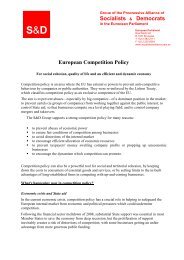Executive summary - Udo Bullmann
Executive summary - Udo Bullmann
Executive summary - Udo Bullmann
- No tags were found...
Create successful ePaper yourself
Turn your PDF publications into a flip-book with our unique Google optimized e-Paper software.
1) Risk taking in the context of growing competition and high performance fees: The crisis ofLTCM and the failure of a great many smaller hedge funds have proved to be only a temporaryset-back for the long-term growth of the hedge fund industry, in terms of both the number ofhedge funds and the size of assets under management. Based on historical experience – and in theabsence of regulation – the industry growth and the extensive use of performance fees is likely togo hand in hand with increasing competition and risk taking that could start another wave offailures among smaller, medium sized and – with lower probability – large hedge funds.2) Growing assets under management: Currently hedge funds manage assets amounting tosomewhere between 6 and 10% of what mutual funds manage. Against this background, it couldbe concluded that the potential impact of failing hedge funds remains small. We believe that thisconclusion is wrong. The amount of assets under management has become quite significant, andit is constantly growing. Furthermore, the failure of a hedge fund may have a far greater marketimpact than the failure of a traditional investment fund managing the same amount of assets. Inthis respect, we point to factors 3-6.3) Short selling: In the light of the current size of assets under management, there can belittle doubt that some hedge funds – using strategies such as short selling – can influence pricesindependent of fundamentals and cause financial instability. This is especially the case in smallerilliquid markets. Yet, it is also not unlikely that it could happen in larger and more liquid markets.4) The increase in correlations: A key concern regarding hedge fund and financial marketstability is related to increasing similarities or correlation among hedge fund strategies. Wherehedge funds are pursuing similar strategies there is an increasing risk that they will buy or selltheir positions at the same time thereby disturbing liquidity. This could in turn leave hedge fundsand third parties like banks and institutional investors highly vulnerable to adverse marketdynamics.5) The tendency to concentrate investments in less liquid markets: In addition to increasingcorrelations, observers have stressed that the liquidity of many hedge fund investments may bedecreasing. Thus, ever more hedge funds have been turning to increasingly exotic strategies andless liquid markets in order to earn the associated liquidity premium. These strategies increase thevulnerability to redemption risks in the advent of a crisis.6) High leverage and the concentration in complex derivative products: We have argued thata boom in leverage and risk may go unnoticed, because the boom is originating from marketscharacterised by great opacity, e.g. the market for credit derivatives. Leverage risk can, if it is notsupported by adequate “emergency” borrowing capacity or reserves of liquid assets, force ahedge fund to default on its obligations to prime brokers and other financial institutions therebysetting in motion a domino effect threatening financial stability.Having summarised the hedge fund related factors that we believe could pose a threat tofinancial market stability we would like to emphasise the great lack of information regardingmany of these factors. Without transparency and reliable data it is difficult to take make informedconclusions about threats and to take proportionate regulatory action to prevent or counter thosethreats.





